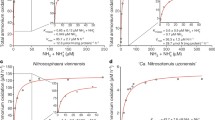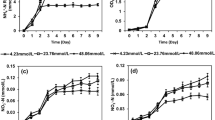Abstract
Chemolithotrophic nitrifying bacteria are dependent on the presence of oxygen for the oxidation of ammonium via nitrite to nitrate. The success of nitrification in oxygen-limited environments such as waterlogged soils, will largely depend on the oxygen sequestering abilities of both ammonium- and nitrite-oxidizing bacteria. In this paper the oxygen consumption kinetics of Nitrosomonas europaea and Nitrobacter winogradskyi serotype agilis were determined with cells grown in mixed culture in chemostats at different growth rates and oxygen tensions.
Reduction of oxygen tension in the culture repressed the oxidation of nitrite before the oxidation of ammonium was affected and hence nitrite accumulated. K m values found were within the range of 1–15 and 22–166 μM O2 for the ammonium- and nitrite-oxidizing cells, respectively, always with the lowest values for the N. europaea cells. Reduction of the oxygen tension in the culture lowered the half saturation constant K m for oxygen of both species. On the other hand, the maximal oxygen consumption rates were reduced at lower oxygen levels especially at 0 kPa. The specific affinity for oxygen indicated by the V max/K m ratio, was higher for cells of N. europaea than for N. winogradskyi under all conditions studied. Possible consequences of the observed differences in specific affinities for oxygen of ammonium-and nitrite-oxidizing bacteria are discussed with respect to the behaviour of these organisms in oxygen-limited environments.
Similar content being viewed by others
References
ArmstrongW (1964) Oxygen diffusion from the roots of some British bog plants. Nature 204: 511–519
ArmstrongW (1979) Acration in higher plants. Adv Bot Res 7: 225–232
BockE, HeinrichG (1969) Morphologische und physiologische Untersuchungen an Zellen von Nitrobacter winogradskyi Buch. Arch Mikrobiol 69: 149–159
BothGJ, GerardsS, LaanbroekHJ (1992a) The occurrence of chemolitho-autotrophic nitrifiers in water-saturated grassland soils. Microb Ecol 23: 15–26
BothGJ, GerardsS, LaanbroekHJ (1992b) Kinetics of nitrite oxidation in two Nitrobacter species grown in nitrite limited chemostats. Arch Microbiol 157: 436–441
ButtonDK (1985) Kinetics of nutrient-limited transport and microbial growth. Microbiol Rev 49: 270–297
ChristensenPB, SørensenJ (1986) Temporal variation of denitrification activity in plant-covered, littoral sediment from Lake Hampen, Denmark. Appl Environ Microbiol 51: 1171–1179
EisenthalR, Cornish-Bowden (1974) The direct linear plot, a new graphical procedure for estimating enzyme kinetics parameters. Biochem J 139: 715–720
FrijlinkMJ, AbeeT, LaanbroekHJ, BoerWde, KoningsWN (1992) The bioenergetics of ammonia and hydroxylamine oxidation in Nitrosomonas europaea at acid and alkaline pH. Arch Microbiol 157: 194–199
GayG, JosserandA, BardinR (1983) Growth of two serotypes of Nitrobacter in mixotrophic and chemoorganotrophic conditions. Can J Microbiol 29: 394–397
HanakiK, WantawinC, OhgakiS (1990a) Nitrification at low levels of dissolved oxygen with and without organic loading in a suspended-growth reactor. Water Res 24: 297–302
HanakiK, WantawinC, OhgakiS (1990b) Effects of the activity of heterotrophs on nitrification in a suspended-growth reactor. Water Res 24: 289–296
HealyFP (1980) Slope of the Monod equation as an indicator of advantage in nutrient competition. Microb Ecol 5: 281–286
HelderW, VriesRTPde (1983) Estuarine nitrite maxima and nitrifying bacteria (Ems-Dollard estuary), Neth J Sea Res 17: 1–18
LaanP, Berrevoets, LytheS, Armstrong W, BlomCWPM (1989a). Root morphology and aerenchym formation as indicators for the flood-tolerance of Rumex species. J Ecol 77: 693–703
LaanP, SmoldersA, BlomCWPM, ArmstrongW (1989b) The relative roles of internal aeration, radial oxygen losses, iron exclusion and nutrient balance in flood-tolerance of Rumex species. Acta Bot Neer 38: 131–145
LaanbroekHJ, PfennigN (1981) Oxidation of short-chain fatty acids by sulphate-reducing bacteria in freshwater and in marine sediments. Arch Microbiol 128: 330–335
PainterHA (1986) Nitrification in the treatment of sewage and waste-water. In: ProsserJI (ed) Nitrification. IRL Press, Oxford Washington, pp 185–221
ProsserJI (1989) Autotrophic nitrification in bacteria. Adv Microbial Physiol 30: 125–181
Sand-JensenK, PrahlS, StokholmH (1982) Oxygen release from submerged aquatic macrophytes. Oikos 38: 349–354
SchmidtEL (1982) Nitrification in soil. In: StevensonFJ (ed) Nitrogen in agricultural soils. American Society of Agronomy Madison, Wis., pp 253–288
SchöberlP, EngelH (1964) Das Verhalten der nitrifizierten Bakterien gegenüber gelöstem Sauerstoff. Arch Mikrobiol 48: 393–400
SharmaB, AhlertRC (1977) Nitrification and nitrogen removal. Water Res 11: 897–925
SmithAJ, HoareDS (1963) Acetate metabolism by Nitrobacter agilis in relation to its “obligate autotrophy”. J Bacteriol 95: 844–855
TerryKR, HooperAB (1970) Polyphosphate and orthophosphate content of Nitrosomonas europaea as a function of growth. J Bacteriol 103: 199–206
VanGoolAP, TobbackPP, FischerI (1971) Autotrophic growth and synthesis of reserve polymers in Nitrobacter winogradskyi. Arch Mikrobiol 76: 252–264
VerhagenFJM, LaanbroekHJ (1991) Competition for ammonium between nitrifying and heterotrophic bacteria in dual energy-limited chemostats. Appl Environ Microbiol 57: 3255–3263
WardBB (1987) Kinetics studies on ammonium and methane oxidation by Nitrosococcus oceanus. Arch Microbiol 147: 126–133
WatsonSW, BockE, HarmsH, KoopsH-P, HooperAB (1989) Nitrifying bacteria. In: StaleyJT, BryantMP, PfennigN, HoltJG (eds) Bergey's manual of systematic bacteriology, vol 3. Williams and Wilkins, Baltimore Hong Kong London, pp 1808–1834
Author information
Authors and Affiliations
Rights and permissions
About this article
Cite this article
Laanbroek, H.J., Gerards, S. Competition for limiting amounts of oxygen between Nitrosomonas europaea and Nitrobacter winogradskyi grown in mixed continuous cultures. Arch. Microbiol. 159, 453–459 (1993). https://doi.org/10.1007/BF00288593
Received:
Accepted:
Issue Date:
DOI: https://doi.org/10.1007/BF00288593




